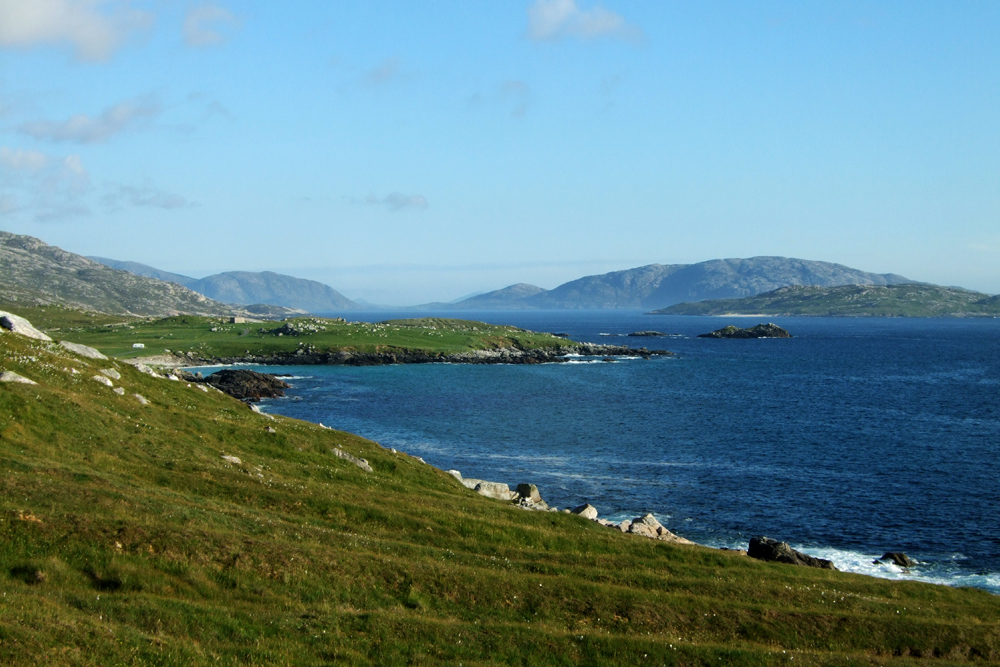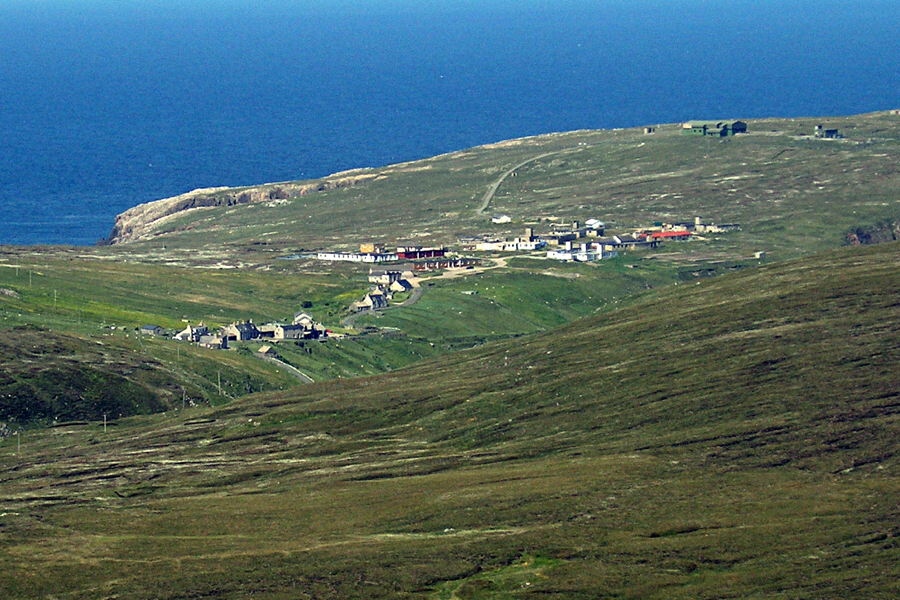Category: History (page 10)
Rev Malcolm Maclennan
Uig Transport in the 1930s-40s
“Strange Conduct of Lewis Crofters”
Highland News, Monday 13 October, 1884:
The Northern Chronicle publishes the following sensational statement which we trust is somewhat exaggerated:– Mr Wm Mackay, Chamberlain of the Lews, has for some time back been engaged in visiting the different parts of the island for the purpose of collecting rents. On Monday last week [30 September 1884] he left for Uig, the people of which district were expected, as customary, to come forward and pay their rents on the following day. The Chamberlain was at Miavaig on Tuesday, to which place a large gathering of crofters and young men marched in a body carrying two banners, on one of which was written “Down with the Landlords” while the other had inscribed on it a Gaelic motto to the effect that the people were stronger than the proprietors. These banners were conspicuously planted in close proximity to Miavaig House, while the people all clustered together on a hillock within a short distance of the road.
The crofters were repeatedly asked to come forward to explain the object of their demonstration, but none answered to the call, until Mr Mackay, recognising one of the men, called him by name, when he came forward and handed the Chamberlain a paper containing requests to the effect that they (the crofters) required all the squatters in the Uig district to be removed off their lands and provided with lands elsewhere; also, that statements be furnished accounting for the expenditure of the school rates, taxes, and road assessments collected for a number of years back; and further that the present holdings of the crofters be increased to the same extent as those occupied by their fore-fathers, and to be held at the old rents.
Meeting at Islivig School, 1908
Miavaig
Rev DA Macrae was born in Miavaig and lived latterly in Harris. He was interviewed by Maggie Smith in November 2004, and died in July 2005.
Our home Miavaig House was built in 1855 for my grandfather James Macrae, who was the Registrar of Births, Deaths and Marriages and was also an Inspector of the Poor. He was responsible for the Parish of Uig which in those days reached as far as Carloway. At this time there was great poverty and the Destitution Board sent a boat into Loch Roag to deliver meal for distribution amongst the poor. There had been widespread potato blight and I’ve heard of one of the Destitution roads built at this time, in Geshader in this district. This was known as Rathad a’Bhuntata as those building the road were paid in potatoes.
I remember a jetty in front of Miavaig House; this was used to offload the supplies for the destitution stores. The meal store was part of Miavaig House. As the years passed the house was being flooded by the tide, it was eventually knocked down and today Miavaig House is higher up the shore. At low tide the old jetty, used to unload the stores can still be seen today. But in my young days a relative of ours, Duncan Macrae from Callanish had the first motor boat I ever saw, and he brought stores and people to Miavaig pier about three times a week. In those days the Uig people travelled by sea to Callanish if they were going to Stornoway, or any other part of the island, as it saved the very long walk to Garynahine.
More about Angus Beag
The Origins of the Macaulays of Uig
From Rev William Matheson, Mac Gille Chaluim, in his Families of Lewis series in the Stornoway Gazette:
Most West Highland clans have to go back some seven hundred years to find their eponymous ancestor. If the Macaulays of Lewis conform to this pattern, we should look for the original Olafr or Aulay about the beginning of the thirteenth century, when the Hebrides were still under Norse domination; and it is a fact, as we know from the Chronicle of Man, that one so called had close connections with Lewis at that time – no less a person than Olaf the Black, who in later years was to become King of Man and the Isles. It is not therefore surprising that Dr George Mackenzie who was doubtless acquainted with the Chronicle of Man as abridged by Camden, makes Olaf the ancestor of the clan.
It is possible that Olaf the Black left descendants in Lewis, but there is no real evidence on the point. There was a tradition among the Macaulays in Uig that they were descended from Magnus, King of Norway, while in Lord Macaulay’s [Thomas Babington Macaulay, 1800-1859, historian and politician] family a similar tradition gave the name as “Olaus Magnus, King of Norway”. The occurrence of the name Magnus may be of significance, for Olaf the Black did, in fact, have a son so called.
More Rebuking in 1825
A Rebuking in 1825
The Kirk Session Wonders Where the Money Went
Clipping Day at Loch Suainebhat, 1970s
Petition for the Arrest of Mac an t-Sronaich, 1834
Mac an t-Sronaich was a notorious and shadowy murderer and robber of Lewis legend who was active in Uig in the early 19th century. He lived in a cave behind Keose in Lochs that is still known as Uamh Mac an t-Sronaich and he was reputedly the first cousin of Lilly Macaulay Linshader, the wife of Rev Robert Finlayson, Keose Manse. On many occasions he found refuge at the manse at Keose and Lilly would leave food for him in one of the outhouses. Tradition maintains that on occasion he slept in the manse, and the marks in the panelling above his bed show where he would stick his dagger overnight.
When things got hot for him, he came to Uig: “As long as I keep to the Uig hills, the Uig hills will keep me,” he said.
The only person reputed to have frightened Mac an t-Sronaich was Domhnall Ruadh Beag from Enaclete. Mac an t-Sronaich was on the hill Mula Chaolartain and he saw something going down the side of Beinn a Deas, the route to Hamnaway. Domhnall Ruadh Beag was barefoot and taking a herring net on his back to Loch Hamnaway where there were huge shoals of herring being caught. All Mac an t-Sronaich could see was this round black thing moving along on little white legs. He couldn’t understand what it was and came to the conclusion it was the devil himself.
Aird Uig in 1959
A chapter from Uig, a Hebridean Parish (1960) by Madge Phillips.
The little township of Aird is an isolated and old-established crofting settlement along the western side of the steep and narrow valley of the Amhainn Gil na h-Airde three miles north of Crowlista. After leaving Loch Meacheit, the river flows northward through a gorge (at the mouth of which are the ruins of the old corn-mill) then across a narrow flood-plain into the rocky bay of Camus na h-Airde. The crofts, roughly fan-shaped in arrangement and varying in size from 3 3/4 to 7 acres, each originally included a narrow strip of the flood-plain, stretchng across from just beyond the right bank of the river, up the steep, rocky slope above the left bank and widening out over the more gentle slopes between the 100′ and 200′ contours. A number of the crofts were subsequently enlarged, gaining extra land on the right bank of the stream, whilst others received additional ground to the north or south.
The 1700 acres of common pasture stretch to the east and west of the crofts, across the peninsula which terminates in Gallan Head, extending to those of Crowlista and Valtos in the south. The whole coast is broken and rocky, the land inland is peaty, and Aird lacks the advantages of the machair land found further west. To the north of the village there is now an RAF radar station on Rudha Caol, built on what was part of the common pasture. It dominates the landscape and makes a considerable difference to the life of the inhabitants.
The township, though isolated, is reached by a good road which leaves the main road at the western end of Glen Valtos. Grocery vans call on Wednesday and Friday, a butcher’s van on Saturday, and the local people are also allowed to shop at the NAAFI within the Camp. The road through the village approximately follows the line of the 100’ contour and all the houses are built directly on to the road, with byres, weaving sheds and other buildings behind, whilst in most cases hens are kept on the steeper slopes below the road. The majority of the houses are stone with slate roofs and fairly large, though some of them have been built for more than fifty years. All have electric light and their own water supply and several have modern byres.
Valtos School 1958
Ailig Mackay and his son Calum, 15 Valtos
Clach Aonghais Bhig
Proposals for Emigration, 1851
Following his tour of the island in the spring of 1851 to assess arrears owed by tenants and determined which of them were “to be emigrated”, the Chamberlain of the Lews, John Munro Mackenzie, drew up the following memorandum (from the Acair publication of his 1851 Diary.) Two emigrant ships, the Marquis of Stafford and the Barlow, sailed from Loch Roag in May and June of 1851.
1. 112 families have volunteerd to emigrate this season. 184 families have been told that they may avail themselves of the proposed means of emigration, which latter number are on an average upwards of £10 in arrears of Rent and the greater number of whom have not any visible means for their support till next crop.
2. It is proposed that the emigrants shall embark during the month of May 1851 either at Stornoway or Loch Roag as may be arranged, a free passage and food during the voyage being secured to them.
3. The locality fixed on as their destination in Qubec [sic] in the first place from when they will be forwarded to the Eastern Townships of Lower Canada, or Montreal in their option.
4. On arrival at Qubec the ordinary Govt Tax or Head Money will be paid by the party sending the Emigrants and for which Tax the Government Emigration Agent will forward them from Qubec to the above localities where employment and land can be procured.
5. By the summonses of removal executed it cannot be inferred that compulsory emigration is in contemplation.
The Loss of the Margaret

On Saturday, 12 March, 1932, a north westerly gale was blowing and a heavy Atlantic swell was running. When Angus MacKinnon, skipper of the lobster boat, Margaret, saw the inclement weather conditions, he woke his father, Cain, and requested his assistance as an extra hand on the boat. Though retired from fishing, Cain agreed. Angus’s younger brother Calum was also a crew member, but his father decided that he should not accompany them.
At daybreak on that fateful morning, two Brenish boats were launched at Molinish. Strong arms and robust backs were required to haul the boats down the shingle beach and out into the Atlantic swell. With their sails unfurled, one boat headed for the lobster pots they had set opposite Brenish while the Margaret headed in the opposite direction to their pots behind Eilean Mealista.
The Margaret was seen dipping in the heavy swell and about to round Eilean Mealista but was never seen intact again. Paradoxically, the bad weather only lasted for a couple of hours and the rest of the day was calm.



